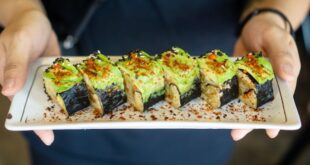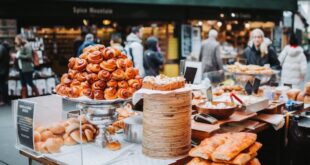Last Updated on November 17, 2023
There is no better way to embrace the vibrant tapestry of different cultures than by diving headfirst into the bustling world of food markets. These lively hubs of culinary delights are often the heart and soul of a destination, filled with sights, sounds, and smells that tantalize the senses. Dozens of such markets exist globally, but we have highlighted a handful that must be visited if you ever find yourself in their city. So, prepare to embark on a gastronomy journey exploring some of the world’s most remarkable food markets.
Best Food Markets Around the World
La Boqueria Market in Barcelona, Spain
Our food market adventure begins with a paradise for foodies, the La Boqueria Market or Mercat de Sant Josep de la Boqueria. Barcelona is an incredible city that has so much to see and do. Sports fans and those who frequent the best Texas bookies online will know the city for its successful soccer team, FC Barcelona. In contrast, architecture lovers know Barcelona is where you find some of the awe-inspiring works of Andoni Gaudi. Barcelona is a city that has it all, including one of the world’s best food markets.
Located just off La Rambla, the market is full of stalls brimming with colorful fresh produce, aromatic herbs, and abundant local specialties. Be sure to try some Spanish ham and, of course, Barcelona’s paella, which is prepared in giant pans before your eyes.
La Boqueria has the best atmosphere of all the food markets, thanks to locals and tourists coming together to share their love for fresh and flavorful food.
Tips for Exploring La Boqueria Market in Barcelona, Spain
1. Rise with the Sun: For the best experience at La Boqueria Market, arrive early to beat the crowds and enjoy the market coming to life. This ensures a more relaxed atmosphere and the chance to explore without the hustle and bustle.
2. Connect with Vendors: Engage with the passionate local vendors. Don’t hesitate to ask questions, seek recommendations, and learn about the products. This personal interaction enhances your culinary journey and adds a cultural touch to your market experience.
3. Off the Beaten Path: Explore beyond the main aisles to discover hidden gems and unique stalls. Some of the best finds are tucked away in the narrower alleys, offering a more intimate and authentic experience.
4. Taste Before You Buy: Take advantage of the tasting culture at La Boqueria. Many vendors offer samples of their products, allowing you to try before making a purchase. From Jamón Ibérico to local cheeses, embrace the opportunity to expand your palate.
Bonus: Mindful Exploration: Respect the space and be considerate of others. Avoid blocking stalls or walkways, and dispose of waste responsibly. This ensures a pleasant experience for everyone and maintains the cleanliness of the market.
Share tips for exploring Marrakech.
What’s your favorite global market?
The Grand Bazaar in Istanbul, Turkey
The enchanting city of Istanbul, Turkey, is next on our food market list, with the Grand Bazaar a must-visit location if you are ever fortunate enough to find yourself visiting Turkey. The market is a labyrinth of alleyways, with stalls as far as the eyes can see. Here, you will discover some authentic Turkish delights, dried fruits, spices you may not have known about, and the famously strong Turkish coffee.
A section of the market is known locally as the Egyptian Bazaar, and it is here you should head if you are a spice aficionado. It is an aromatic wonderland where friendly vendors are more than happy to share the secrets of their spice blends and often give you a taste of their offerings.
The Grand Bazaar also has more than its fair share of street food vendors, selling everything from freshly prepared lamb kebabs to sweet baklava. Be prepared to haggle with the vendors because many stalls do not have prices, and those that do are not set in stone; you may just bag yourself a culinary bargain.
Tips for Exploring The Grand Bazaar in Istanbul, Turkey
1. Navigate Early, Haggle Wisely: To experience The Grand Bazaar in its full glory, arrive early to avoid the peak crowds. As you explore the labyrinth of stalls, embrace the art of haggling. Many prices are negotiable, so engage in a friendly negotiation for a more authentic market experience. Remember, a respectful approach often leads to better deals.
2. Focus on the Egyptian Bazaar for Spices: Dive into the aromatic wonders of the Egyptian Bazaar, a section within The Grand Bazaar dedicated to spices. Engage with knowledgeable spice vendors who are eager to share the secrets of their blends. Enjoy samples, ask for recommendations, and explore the myriad colors and scents that make this section a true sensory delight.
3. Street Food Adventures: Immerse yourself in Istanbul’s culinary scene by indulging in street food at The Grand Bazaar. From freshly grilled kebabs to sweet baklava, the market offers a diverse range of delectable treats. Be prepared to haggle with street food vendors, and don’t shy away from trying local specialties that catch your eye.
4. Uncover Hidden Treasures: While the main alleys of The Grand Bazaar are bustling, take time to wander through less crowded areas and hidden corners. This is where you may stumble upon unique stalls and authentic Turkish crafts. Exploring off the beaten path provides a more intimate experience and a chance to discover hidden treasures.
Bonus Tip: Respect the Craftsmanship: Many items in The Grand Bazaar are handmade by skilled artisans. Whether it’s intricate carpets, beautiful ceramics, or unique jewelry, take a moment to appreciate the craftsmanship. Engage with the sellers to learn about the stories behind the products, fostering a deeper connection with the rich cultural heritage of Istanbul.
Tsukiji Fish Market in Tokyo, Japan
The Tsukiji Fish Market is one of the best markets in Tokyo, Japan. And it is an absolute haven for seafood lovers. Seafood is a staple food for Japanese natives, so it makes perfect sense that Tokyo is where you find the world’s largest fish market.
Each day, as the sun rises, vendors prepare their stalls for the day’s catch, and the air is filled with the sea’s salty aroma. The market offers an unrivaled selection of seafood, from fresh lobsters to the freshest sushi you will ever have the joy of tasting, to all the ingredients required to make dashi. This flavorful broth forms the base of many Japanese dishes.
Tips for Exploring Tsukiji Fish Market in Tokyo, Japan
1. Early Bird Advantage: Make the most of your visit to Tsukiji Fish Market by arriving early in the morning. The market comes alive before the sun rises, offering a firsthand look at the bustling seafood auctions. Early visitors not only witness the day’s catch being prepared but also avoid the crowds, ensuring a more intimate and immersive experience.
2. Dive into Seafood Varieties: Tsukiji Fish Market boasts an unparalleled selection of seafood. Take the opportunity to explore diverse marine delicacies, from fresh sashimi to unique species you might not find elsewhere. Engage with vendors who are often passionate about their offerings, providing insights into the different flavors and textures of Japan’s rich seafood culture.
3. Savor Street Food: While the market is renowned for its fresh seafood, don’t miss out on the delectable street food offerings. From sushi rolls to grilled scallops, many stalls offer on-the-go treats that capture the essence of Japanese cuisine. Take the time to indulge in these culinary delights and embrace the casual, authentic atmosphere of the market.
4. Respect the Working Environment: Tsukiji Fish Market is a place of business for many hardworking individuals. Be mindful of the workers’ spaces, follow designated paths, and avoid disrupting ongoing transactions. While photography is often allowed, be considerate and ask for permission when capturing moments, respecting the daily routines of those who make the market thrive.
Bonus Tip: Visit the Outer Market: After exploring the inner wholesale market, venture into the outer market for a wider array of food options. Here, you’ll find sushi restaurants, stalls selling kitchen tools, and shops offering Japanese culinary souvenirs. The outer market provides a more relaxed atmosphere for enjoying a sit-down meal and further immersing yourself in Tokyo’s seafood culture.
Nghia Tan Market in Hanoi, Vietnam
Our culinary adventure continues in eastern Asia as we head to Hanoi, Vietnam. Hanoi’s streets are a market in their own right, street food vendors and food stalls are everywhere, and the combination of smells is nothing short of incredible.
The city’s busy food scene is a testament to its rich culinary traditions. The narrow streets of the Old Quarter are where you will find some tempting local dishes, including piping hot bowls of pho, delicious banh mi sandwiches, and anything and everything else in between.
Nghia Tan Market, nestled in the heart of Hanoi, Vietnam, is a bustling and vibrant locale that encapsulates the essence of the city’s rich culinary and cultural heritage. This lively market has been a cornerstone of the local community for decades, offering an array of tantalizing street food, fresh produce, and an immersive cultural experience.
What sets Nghia Tan Market apart is its eclectic mix of street vendors and stalls that serve a wide variety of Vietnamese dishes. From piping hot bowls of Pho and crispy Banh Mi sandwiches to delectable spring rolls and the famous bun cha, this market is a haven for food enthusiasts seeking to savor authentic flavors. The aroma of grilled meats, herbs, and spices fills the air, creating an enticing and mouthwatering atmosphere for both locals and tourists.
Tips for Exploring Nghia Tan Market in Hanoi, Vietnam
1. Dive into Morning Freshness: To truly experience the lively atmosphere of Nghia Tan Market in Hanoi, start your exploration in the morning. This is when the market is at its bustling best, with locals and vendors preparing for the day ahead. Arriving early allows you to witness the market coming to life, enjoy the freshest produce, and engage with vendors before the crowds set in.
2. Embrace Street Food Extravaganza: Hanoi is renowned for its street food, and Nghia Tan Market is no exception. Immerse yourself in the diverse flavors of Vietnamese cuisine by exploring the street food stalls within the market. From piping hot bowls of pho to savory banh mi sandwiches, this market is a haven for food enthusiasts seeking authentic Vietnamese tastes. Don’t be afraid to try new dishes and savor the rich tapestry of local flavors.
3. Wander the Old Quarter Streets: Nghia Tan Market is situated in the heart of Hanoi’s Old Quarter, known for its narrow streets and historic charm. After exploring the market, take a leisurely stroll through the Old Quarter’s bustling streets. This area is a microcosm of Hanoi’s rich cultural heritage, offering glimpses into traditional Vietnamese architecture, local life, and additional street food options.
4. Engage with Local Vendors: To enhance your market experience, interact with the friendly vendors at Nghia Tan. Many vendors are passionate about their products and eager to share insights into Vietnamese culinary traditions. Whether you’re purchasing fresh produce, trying a local snack, or simply enjoying the vibrant atmosphere, engaging with the vendors adds a personal touch to your exploration.
Bonus Tip: Be Mindful of Cultural Etiquette: Respect local customs and be mindful of cultural etiquette while exploring Nghia Tan Market. In Vietnam, it’s common to greet vendors with a friendly “Xin chào” (hello) and a smile. When taking photographs, ask for permission, especially if capturing people or their stalls. Showing appreciation for the local customs enhances the overall experience and fosters positive interactions.
Borough Market in London, UK
Borough Market, located in the heart of London, is a renowned food market and culinary destination that has a history dating back over 1,000 years. This vibrant and bustling market is a mecca for food enthusiasts, offering a diverse range of fresh produce, artisanal goods, and gourmet treats.
Visitors to Borough Market are greeted with a sensory overload of sights, sounds, and aromas. The market’s cobblestone streets are lined with stalls and vendors selling everything from fresh, locally sourced ingredients like cheeses, bread, and charcuterie to international delicacies, street food, and exotic spices. It’s a place where food producers, farmers, and artisans come together to showcase their wares, creating a unique and dynamic environment.
Beyond the delectable food offerings, Borough Market has also become a hub for culinary community in London, hosting cooking demonstrations, workshops, and events. This market is more than just a place to shop; it’s a cultural and gastronomic experience that celebrates the finest in food and showcases the spirit of London’s food scene. With its rich history and modern-day charm, Borough Market is a must-visit destination for food lovers and tourists in London, offering a taste of the city’s diverse and vibrant food culture.
Tips for Exploring Borough Market in London, UK
1. Dive into Morning Freshness: To truly experience the lively atmosphere of Nghia Tan Market in Hanoi, start your exploration in the morning. This is when the market is at its bustling best, with locals and vendors preparing for the day ahead. Arriving early allows you to witness the market coming to life, enjoy the freshest produce, and engage with vendors before the crowds set in.
2. Embrace Street Food Extravaganza: Hanoi is renowned for its street food, and Nghia Tan Market is no exception. Immerse yourself in the diverse flavors of Vietnamese cuisine by exploring the street food stalls within the market. From piping hot bowls of pho to savory banh mi sandwiches, this market is a haven for food enthusiasts seeking authentic Vietnamese tastes. Don’t be afraid to try new dishes and savor the rich tapestry of local flavors.
3. Wander the Old Quarter Streets: Nghia Tan Market is situated in the heart of Hanoi’s Old Quarter, known for its narrow streets and historic charm. After exploring the market, take a leisurely stroll through the Old Quarter’s bustling streets. This area is a microcosm of Hanoi’s rich cultural heritage, offering glimpses into traditional Vietnamese architecture, local life, and additional street food options.
4. Engage with Local Vendors: To enhance your market experience, interact with the friendly vendors at Nghia Tan. Many vendors are passionate about their products and eager to share insights into Vietnamese culinary traditions. Whether you’re purchasing fresh produce, trying a local snack, or simply enjoying the vibrant atmosphere, engaging with the vendors adds a personal touch to your exploration.
Bonus Tip: Be Mindful of Cultural Etiquette: Respect local customs and be mindful of cultural etiquette while exploring Nghia Tan Market. In Vietnam, it’s common to greet vendors with a friendly “Xin chào” (hello) and a smile. When taking photographs, ask for permission, especially if capturing people or their stalls. Showing appreciation for the local customs enhances the overall experience and fosters positive interactions.
Chatuchak Weekend Market, Bangkok, Thailand
No exploration of global food markets is complete without a mention of one of the best food market in Bangkok, Thailand, and its vibrant Chatuchak Weekend Market. This sprawling market, also known as JJ Market, stands as one of the largest and most diverse weekend markets in the world. While it’s renowned for its eclectic array of goods, from clothing to antiques, it’s the food section that truly steals the show.
Venture into the maze of stalls, and you’ll find yourself surrounded by the aromatic symphony of Thai street food. From the sizzling pad thai cooked to perfection in giant woks to the tantalizing aroma of coconut-based green curry, Chatuchak Market offers an unparalleled culinary experience. Here, you can sample an array of Thai delicacies, including mango sticky rice, grilled satay skewers, and the iconic tom yum soup.
As you navigate through the crowded alleys, don’t miss the chance to indulge in exotic tropical fruits, freshly squeezed sugarcane juice, and Thai-style iced tea. The market provides a perfect opportunity to immerse yourself in the rich and diverse flavors of Thai cuisine, all while surrounded by the lively energy of locals and tourists alike.
Tips for Exploring Chatuchak Weekend Market
1. Timing is Key: Given its vast size, Chatuchak Market can be overwhelming. Consider visiting early in the morning to beat the crowds and experience the market at a more leisurely pace.
2. Embrace Street Food Etiquette: Engage with the friendly vendors, inquire about the ingredients, and don’t hesitate to try something new. Many vendors speak English, making it easy for visitors to navigate the culinary offerings.
3. Bargain for Souvenirs: While haggling is expected in the clothing and antique sections, prices for food are typically fixed. However, if you plan to purchase packaged goods or souvenirs, a bit of friendly negotiation might come in handy.
4. Stay Hydrated: Given Bangkok’s tropical climate, it’s essential to stay hydrated. Fresh coconut water or a cold Thai iced tea from one of the market stalls can be both refreshing and culturally enriching.
Marrakech Souk, Marrakech, Morocco
Wander through the labyrinthine alleys of the souk, where each turn reveals a new treasure trove of Moroccan flavors. Engage with spice merchants who take pride in sharing the secrets of Ras el Hanout and other unique spice blends. Don’t miss the opportunity to savor local delicacies such as lamb tagine with apricots, couscous infused with aromatic herbs, and the renowned pastilla, a flaky pastry filled with spiced meat and almonds.
For a true taste of Moroccan hospitality, visit the tea stalls where sweet mint tea is poured with flair, accompanied by delectable pastries like honey-drenched sfenj and almond-stuffed briouats. The Marrakech Souk is not just a market; it’s a cultural immersion into the soul of Moroccan cuisine.
Tips for Exploring Marrakech Souk
1. Bargain with Respect: Haggling is an integral part of the souk experience, especially when purchasing goods like textiles and crafts. However, when it comes to food, prices are generally fixed. Show respect and appreciation for the craftsmanship while negotiating.
2. Try Traditional Sweets: Explore the sweet side of Moroccan cuisine by indulging in local pastries like ma’amoul and ghriba. These treats, often prepared with a mix of nuts, dates, and aromatic spices, provide a delightful contrast to the savory dishes.
3. Explore the Hidden Corners: Venture beyond the main thoroughfares to discover hidden gems where local vendors prepare lesser-known specialties. The quieter corners often harbor culinary treasures waiting to be savored.
4. Learn the Art of Tea Pouring: Take a moment to witness the intricate process of pouring mint tea, a cultural ritual in Morocco. Engage with tea vendors, learn about the significance of each step, and savor the sweet, aromatic brew.
The Marrakech Souk offers a captivating blend of ancient traditions and vibrant flavors, making it a must-visit for any food enthusiast. As you navigate through its maze-like streets, you’ll not only sample exquisite Moroccan cuisine but also gain insights into the cultural tapestry that defines this North African gem.
Maxwell Food Centre, Singapore
Shift your culinary exploration to the heart of Southeast Asia by delving into the renowned hawker centers of Singapore. These bustling open-air complexes are a testament to the city-state’s diverse culinary landscape, bringing together Chinese, Malay, Indian, and other influences in a symphony of flavors.
Maxwell Food Centre stands out as a quintessential hawker center, located in the heart of Singapore’s Chinatown. Here, you can embark on a gastronomic journey sampling iconic dishes such as Hainanese chicken rice, laksa, char kway teow, and the beloved Hainanese curry rice.
The diverse range of food stalls at Maxwell Food Centre reflects Singapore’s multicultural heritage, offering an opportunity to experience the depth of local flavors. Engage with hawkers who passionately craft their specialties, and don’t be shy to ask for recommendations to navigate the extensive menu.
Tips for Exploring Singapore Hawker Centers
1. Ordering Etiquette: Hawker centers often operate on a self-service basis. Secure a table first, then approach the respective stalls to place your orders. Most stalls only accept cash, so be prepared.
2. Explore Off-Peak Hours: To avoid the crowds and long queues, consider visiting hawker centers during non-peak hours. This allows for a more relaxed dining experience and the chance to interact with hawkers.
3. Share Tables: It’s common practice to share tables in hawker centers, especially during busy hours. Embrace the communal atmosphere, strike up a conversation with fellow diners, and perhaps discover new dishes to try.
4. Chilli and Condiments: Singaporean cuisine often involves a play of flavors enhanced by condiments. Experiment with the various chilli sauces and accompaniments provided at each table to tailor the dishes to your preferred taste.
Singapore’s hawker centers encapsulate the essence of the nation’s culinary identity. From savory delights to sweet treats, each bite tells a story of Singapore’s multicultural heritage. A visit to Maxwell Food Centre promises not only a feast for the taste buds but also a cultural immersion into the dynamic world of Singaporean street food.
Rialto Market in Venice, Italy
Transport yourself to the enchanting city of Venice, Italy, and explore the historic Rialto Market, a culinary haven nestled along the Grand Canal. This bustling market, with its vibrant array of fresh seafood, seasonal produce, and Venetian specialties, offers a true taste of the city’s rich gastronomic heritage.
Start your journey at the Pescheria, the lively fish market section of Rialto, where local fishermen proudly display their catch of the day. Immerse yourself in the vibrant colors and briny aroma of the Adriatic Sea as you peruse stalls laden with an assortment of clams, squid, shrimp, and the iconic Venetian delicacy, bacalà mantecato (creamed salted cod).
As you meander through the market, encounter stalls brimming with fresh fruits, vegetables, and aromatic herbs. Engage with local vendors who are passionate about their produce, offering insights into the seasonality of Venetian ingredients.
Tips for Exploring Rialto Market
1. Early Morning Exploration: To witness the market at its liveliest, arrive early in the morning when fishermen bring in their fresh catches. This is the optimal time to experience the hustle and bustle of Rialto Market.
2. Try Cicchetti: After exploring the market, venture into the surrounding bacari (wine bars) to indulge in cicchetti, Venetian small plates. These bite-sized delights range from marinated seafood to creamy risotto, providing a perfect complement to your market experience.
3. Navigating the Mercato di Rialto: The market is divided into sections—Pescheria for fish, Erberia for fruits and vegetables, and Beccarie for meats. Take your time exploring each area to fully appreciate the diversity of Venetian ingredients.
4. Waterfront Views: The Rialto Market is situated along the Grand Canal, offering stunning views of Venetian architecture. Take a moment to savor the ambiance and enjoy a leisurely stroll along the canal after your culinary exploration.
Tips for Market Exploration
There are a few universal tips to remember regardless of where your food market adventure takes you. The number one rule, the golden rule, is to embrace the local culture. Food markets are cultural gems, so engage with the vendors and locals. Of course, not all of them will speak your native language, but many will do, especially in tourist hotspots. Ask questions, learn phrases, and it will make the experience more enjoyable.
It is also important to try something new; food markets are perfect for stepping out of your comfort zone. By all means, try a locally prepared version of your favorite dish, but push the boat out and sample something that has never before passed your lips.
Always respect the local customs because every market has its own set of unwritten rules. As mentioned, haggling is encouraged in some places but considered disrespectful in others. A quick internet search should uncover the rules and customs of the market you plan to visit.
Lastly, be sure to follow your senses. Let your nose and taste buds guide you. The stalls with the longest lines or the most enticing smells are usually a safe bet that you will enjoy a delicious meal, particularly if that long line is mainly made up of locals.
Conclusion
Food markets combine culture, history, and incredible flavors and are often the hub of a city. Visiting a market connects you with the heart of a destination. It allows you to experience the soul of a place through its food, traditions, and, more importantly, its people.
It does not matter if you are a seasoned traveler or someone in the planning stages of their first international trip, you should include a visit to a food market on your itinerary. It is a journey that will give you lasting memories and a deeper understanding of the country you’re visiting. Bon appetit!
 Travel for Food Hub The Food Blog for Travel Lovers
Travel for Food Hub The Food Blog for Travel Lovers
















